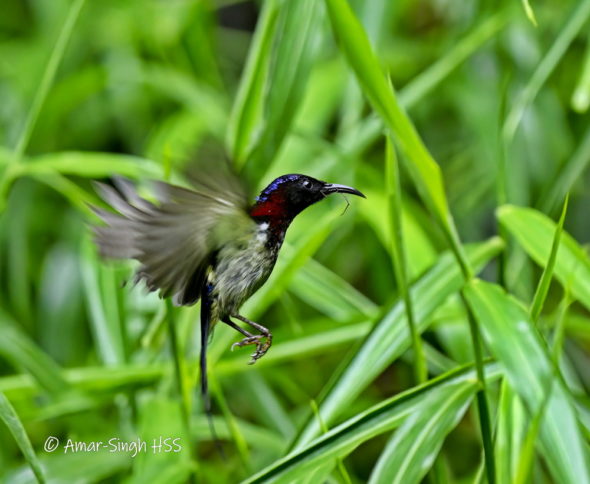On 27th March 2023 I was at approximately 1,800m ASL at Cameron Highlands, Pahang, Malaysia when I saw a male Black-throated Sunbird (Aethopyga saturata) collecting prey to feed juveniles.
I saw the male collecting two insects, one of which was a spider. The prey was kept in the beak and not consumed, hence I have assumed it is being taken to feed juveniles (see Image 1).

Much of the foraging technique was fluttering to identify prey in long grass and vegetation in the darker undergrowth (see Image 2).

This sunbird has the capacity to flutter well. The under-surface of leaves was also inspected for prey. Once the second prey was obtained (identity of insect not known as no images), the bird flew off into a gully, presumably to feed juveniles. Nest and juveniles not seen.
In my many observations of adults over the decades, I have almost always seen them feed on nectar – a list of my nectar and animal sources listed below. I suspect, as in a number of species, that animal prey is collected primarily to feed juveniles.
Prior Personal Observations of Food/Diet
Nectar Sources
1. Abutilon pictum – commonly known as Redvein Abutilon, Red Vein Indian Mallow, Redvein Flowering Maple or Red vein Chinese lanterns (native to South America). Nectar robbing technique used.
2. Abutilon megapotamicum – called the Trailing Abutilon (native to South America). Nectar robbing technique used.
3. Canna – often called Canna Lily. Nectar robbing technique used.
4. Numerous Hibiscus spp. Nectar robbing technique used.
5. Euphorbia species (very much like Euphorbia pulcherrima – Poinsettia). Conventional nectar feeding.
6. Callistemon spp. – commonly known as Bottlebrush. Conventional nectar feeding.
7. Poikilospermum suaveolens (family: Urticaceae) – seen feeding on the flowers (they eat the flowers to get to the nectar).
8. Lantana camara. Conventional nectar feeding.
9. Fuchsia spp. Nectar robbing technique used.
10. Pyrostegia venusta – commonly known as Flamevine or Orange Trumpetvine (originally from Brazil). Nectar robbing technique used.
11. Thunbergia mysorensis – commonly called Lady’s Slipper Vine, Mysore Trumpet-vine or Indian Clock-vine (native to southern tropical India). Conventional nectar feeding.
12. Malvaviscus arboreus – resembles a partially closed hibiscus flower. Nectar robbing technique used.
13. Rhododendron malayanum. Nectar robbing technique used.
14. Buttonbush – a flowering plant is in the family Rubiaceae closer to the Cephalanthus occidentalis.
15. Ipomoea indica (Ocean-blue Morning Glory, an exotic) using nectar robbing technique.
16. There are many other wildflowers use as nectar sources where I am not able to ID the plant.
Animal Prey
Observed very occasionally foraging for invertebrate prey and seen taking spiders.
Dato’ Dr Amar-Singh HSS
Ipoh, Perak, Malaysia
Note to readers: If you like this post please tap on the Like button at the left bottom of page.








